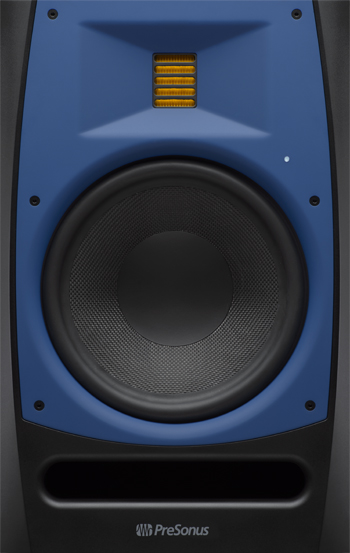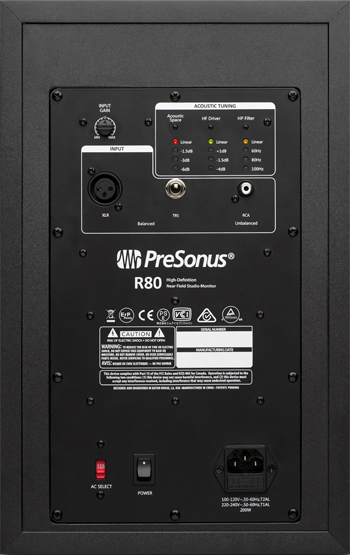|
|
PreSonus R80 Studio Monitor
|
|
|
 |
| PreSonus R80 Studio Monitor |
The R65 has a 6.5-inch, coated Kevlar® woofer, while the R80 comes with an 8-inch woofer. Both monitors feature twin Class-D power amplifiers: 100-watts RMS for the woofer and a separate 50-watts RMS amp driving the AMT tweeter. The R65 frequency response is rated at 50 Hz to 25 kHz while the R80 is rated 45 Hz to 25 kHz.
Both these monitors come with removable blue colored escutcheons or faceplates. If you want an all-black look, an additional black faceplate with replacement instructions and tool is included.
All PreSonus studio monitors are equipped with Acoustic Tuning controls that include: programmable Acoustic Space controls, an adjustable High Frequency driver level control, plus an adjustable High-Pass filter to configure them to work with a separate sub woofer such as PreSonus' Temblor T10.
Testing the R80s
 |
| PreSonus R80 Studio Monitor (Back Panel) |
The R65 measures 8 W X 13 H X 10.3-inches D while the R80 is: 9.5 W X 15 H X 12-inches D and they weigh 14.7 and 19.8 LBS respectively.
In my testing I found them to be initially "dark" sounding for my taste but that was easily remedied by one push on the HF Driver button to bump the tweeter level up by 1dB. Besides flat or the Linear position, HF Driver offers +1, -1.5, and -4dB settings.
I found these monitors to have wide lateral high frequency dispersion for a broader, side-to-side expanded listening area. My "sweet spot" was wider than usual yet I had a focused stereo panorama image with the panned position of each element in my mix clearly discernable. In addition, they have a flattened vertical dispersion that would help to reduce reflections from (acoustically untreated) ceilings and hard floors underneath. This attribute does require that the R80s be properly aimed and toed in towards your listening position--the ribbon tweeters should be even with head height. This vertical directionality might have contributed to my first impression of them being "dark" sounding--I was standing up!
I tried them in the corners of my living room and the Acoustic Space second-order, low-shelving filter came into play. The 250Hz roll-off filter in Acoustic Space has four settings: Linear (as I first used when the R80s were free-standing and away from nearby walls), -1.5, -3, and -6dB. These are good choices that would take care of just about any distance from walls or corners that works with your room's furniture layout. Simply place the R80s where you'd like them and toggle through the four positions in Acoustic Space and see what works for you! In my case, the -1.5 or even the -3dB position took care of the bass build up caused by the nearby walls and corner.
For this, review, I didn't use a sub-woofer with the R80 but when I do, the 24dB/Oct. HP Filter has four positions: Linear, 60, 80 and 100Hz. Home theatre sub-woofers usually require an 80Hz crossover point but one of these will set the crossover point to any sub and situation. Low frequencies are well represented with these R80s and for music mixing, I found no need of a sub-woofer for the quiet to medium SPL levels work.
Great Value and Sound
It's good to know that there are important safety features built into these monitors. You get RF shielding (protection from stray radio signals such as cell phones from entering the audio path), current-output limiting (protects from overdriving the tweeter and woofer), over-temperature protection, and subsonic protection.
There is also an optional standby mode to conserve power when no audio signal is present--this is a good feature to have when running the R80s in a studio where producers are constantly switching between different sets of monitors all the time. After a certain time period of inactivity, the R80s or R65s go to standby mode and require a moment to "wake up" when audio signals comes online to them again.
I think the R80 offers a lot for a powered monitor in its price range. For a home project studio, home theatre, or as a near field reference monitor, you'll be happy with these because they are easily adaptable in any room and in any place in the room and look great!
The PreSonus R65 and R80 sell for $399.95 MAP and $499.95 MAP, respectively. For more information, check: www.presonus.com/products/R-Series-Monitors.
|
|
|